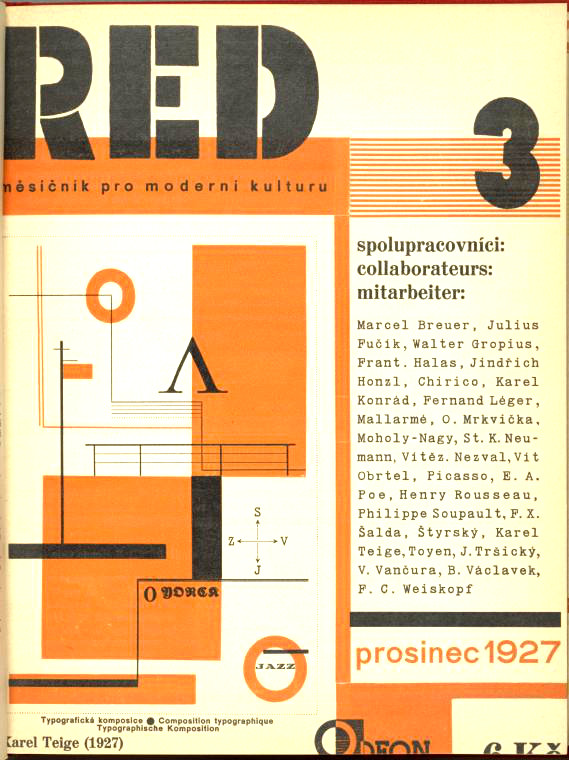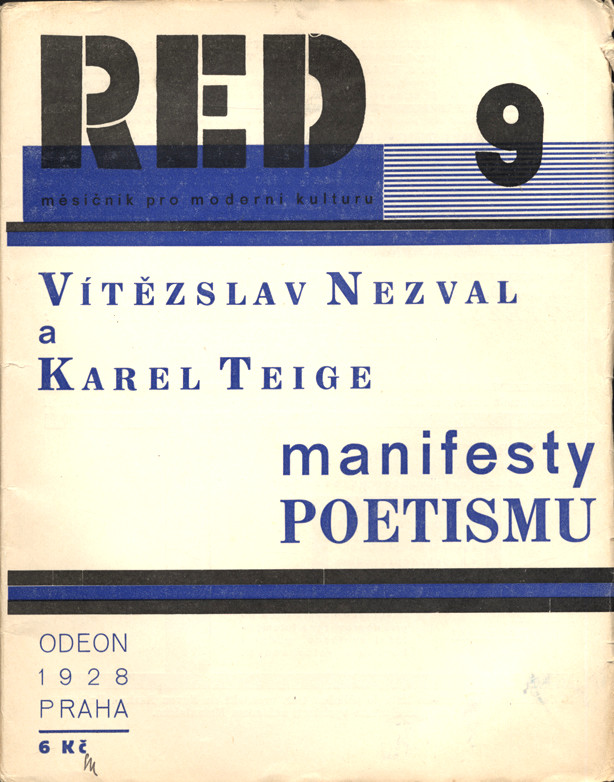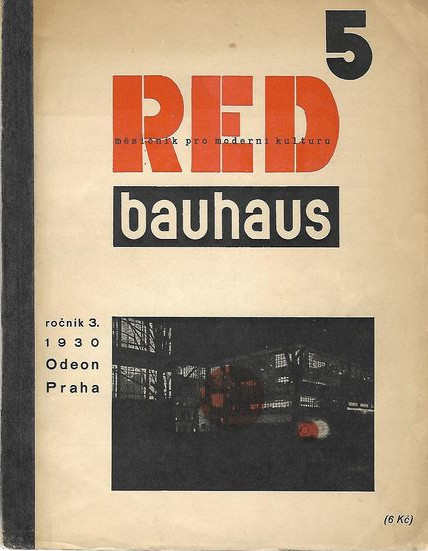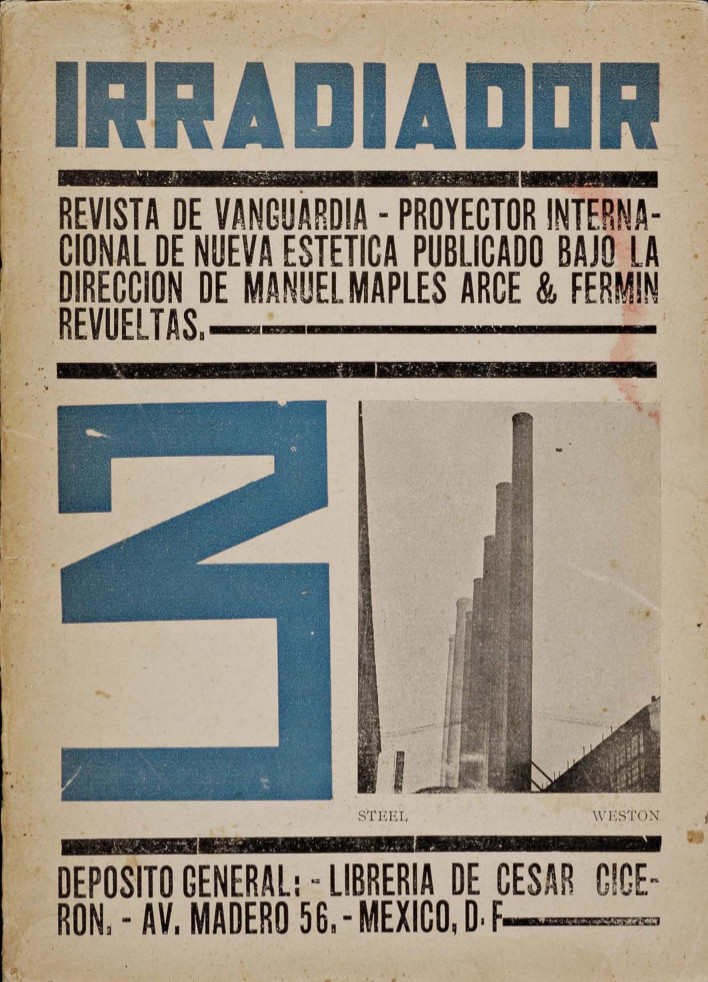ReD (Revue Devětsilu): modern culture monthly (1927-1931) [Czech]
Filed under magazine | Tags: · architecture, art, art theory, avant-garde, bauhaus, constructivism, czechoslovakia, dada, design, film, graphic design, literature, photography, poetry, psychoanalysis, radio, surrealism, theatre



ReD (měsíčník pro moderní kulturu / Revue internationale illustrée de l’activité contemporaine / Internationale Monatsschrift für moderne Gestaltung) was an art magazine published by members of the Czech avant-garde art collective Devětsil.
Thirty numbers were published, with the special issues on the Russian avant-garde, Bauhaus, and photography/film/typography.
Several manifestos appeared in the journal: Toyen and Jindřich Štyrský’s Artificielisme (1:1, 1927), Karel Teige’s second Poetism manifesto [Manifest Poetismu] (1:9, 1928), and the Left Front [Levá fronta]’s founding manifesto (3:2, 1929).
Edited and designed by Karel Teige
Publisher Odeon – Jan Fromek, Prague
via NYPL Digital Library
Each volume in a single PDF (low resolution):
Volume I, 1927-1928 (10 issues, 360 pages)
Volume II, 1928-1929 (10 issues, 324 pages)
Volume III, 1929-1931 (10 issues, 315 pages)
Selected issues in separate PDFs:
The Russian Issue (1:2, Nov 1927)
Foto Film Typo Issue (2:8, Apr 1929)
The Bauhaus Issue (3:5, Feb 1930, partly in German)
JPG pages (search in page annotations):
View online
See also Devětsil: Revoluční sborník (1922), edited by Jaroslav Seifert and Karel Teige, in Czech.
Comment (1)Irradiador: revista de vanguardia, 1–3 (1923) [Spanish]
Filed under magazine | Tags: · art, avant-garde, concrete poetry, estridentismo, literature, mexico, poetry, politics


“The Irradiador journal was edited by the artist Fermín Revueltas (1902-1935) and was the major early voice for the Mexican avant-garde movement called Estridentismo. The journal was short-lived, and only saw three issues: September, October, and November of 1923. Still, it saw contributions by major players in the international avant-gardes, all the while staying carefully attuned to Estridentismo‘s present social concerns for post-revolutionary Mexico.
The journal’s foremost concern was the propagation of the new aesthetics in Mexico, and furthering the cultural project of the Mexican revolution. Irradiador, it promised in its motto, ‘Will make reactionaries lose sleep, and will affirm all the anxieties of the present hour.’
The journal featured woodcuts, sculptures, paintings, poems, and articles on subjects as diverse as archaeology and the petroleum industry. Its first issue contains a calligram by none other than the muralist Diego Rivera–an important endorsement for a nascent avant-garde movement like Estridentismo. It also contained a poem by the Argentine Jorge Luis Borges, which bolsters the international credibility of the Mexican movement.
Other important poets, writers, and artists to be featured over the three issues: Salvador Gallardo, Germán List Arzubide, Kyn Tanya, Juan José Tablada, and the U.S. photographer Edward Weston, whom the magazine inexplicably calls ‘Dwad Weston’ (Irradiador 3, inside cover).
The magazine’s aesthetic is a combination of Mexican images–such as Charlot’s woodcuts of indigenous workers–and modern technology, promoting the ‘Jazz Band, petroleum, New York. The city all polarized crackling in the radiotelephonic antennas…’ (‘Inaugural Irradiation’, 1).” (sourced from Kelly Scott Franklin’s blog)
Scans via The Jean Charlot Collection & the University of Hawaii at Manoa
Commentary by Evorio Escalante (video, 3 min, in Spanish)
Comment (0)Thomas Ort: Art and Life in Modernist Prague: Karel Čapek and his Generation, 1911-1938 (2013)
Filed under book | Tags: · 1910s, 1920s, 1930s, art, art history, austria-hungary, avant-garde, cubism, czechoslovakia, history of literature, literature, philosophy, poetry

“In most histories of Europe before the First World War, modern life in Habsburg Mitteleuropa takes on a decidedly gloomy cast. Centering on Vienna in the twilight years of the Austro-Hungarian Empire, such accounts describe the failure of rationalism and the rise of a dangerous politics of fantasy. This book tells a different story, highlighting a generation of Czech writers and artists distinguished by their affirmative encounter with the modern world in the first decades of the twentieth century. Novelist and playwright Karel Čapek, along with other members of his cohort, embraced the possibilities of the post-Habsburg era. Tracing the roots of Čapek’s generation to cubist art and turn-of-the-century philosophy, author Thomas Ort shows that the form of modernism they championed led not into the thickets of fascism or communism but in fact closer to liberal political ideals.”
Publisher Palgrave Macmillan, 2013
Palgrave Studies in Cultural and Intellectual History series
ISBN 1137188863, 9781137188861
276 pages

